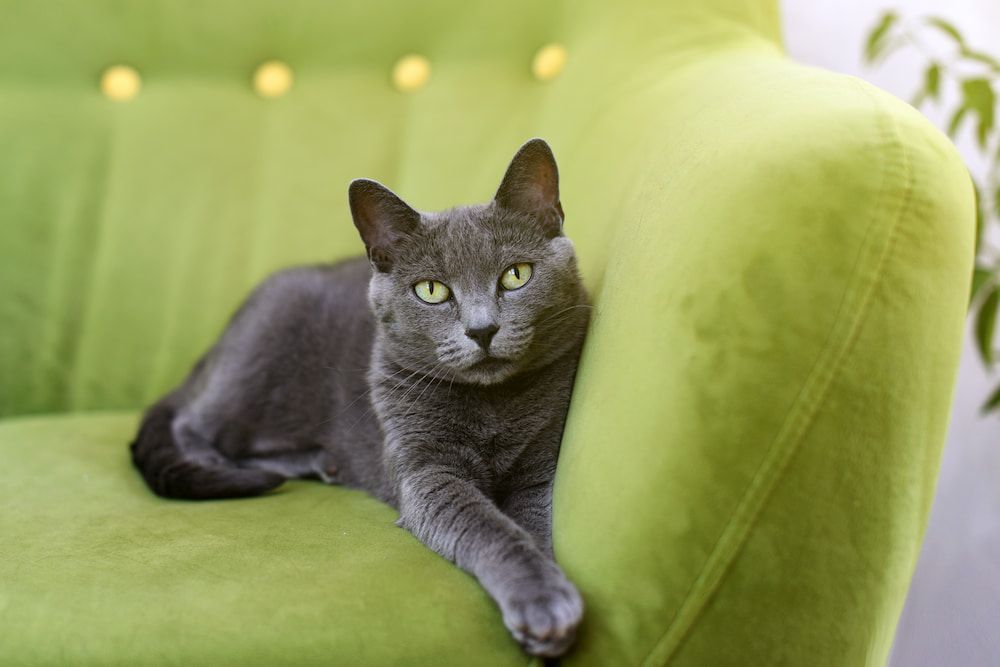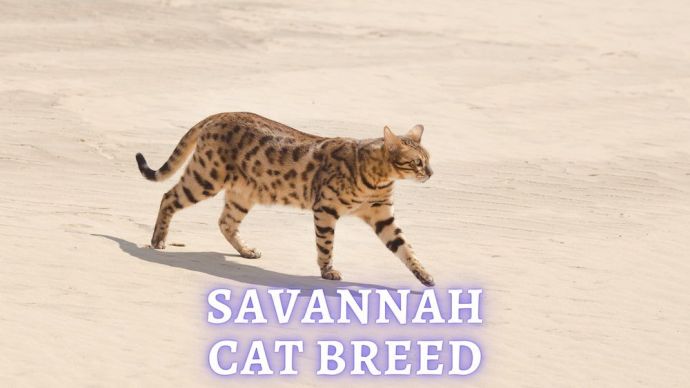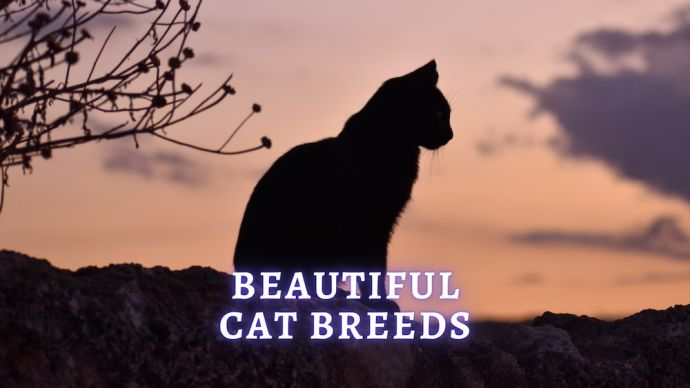Russian Blue Cat: Breed History, Personality and Price
Written by:
Author: Vicki Smirnova
Vicki Smirnova is a professional writer and editor who adores animals and helps readers get along well with their pets. She has been working in digital media for more than 5 years and has great experience writing content about lifestyle, including pets. Vicki specializes in dog health and nutrition, cat feeding, dog training. She is an aquarium lover and is passionate to write about fish care at home. Also, Vicki headed several websites and worked as a news editor.
View all 244 articlesLearn about our editorial process and veterinary review board.
Viewed: 162
Updated on: 12/24/2022
The Russian blue cat, known in Russia only at the beginning of the felinological movement, is a naturally occurring breed from northern Russia and is recognized by international felinological organizations. The Russian blue cat is one of the most popular shorthair cat breeds.
| Weight | 7-12 pounds |
| Height | 9-11 inches |
| Colors and Patterns | blue/gray, solid color |
| Lifespan | 15-25 years |
| Suitable for | Families looking for an active, playful cat |
History of the breed
According to the most common version, the Russian blue cat, which migrated to Great Britain and northern Europe on merchant ships in the mid-1860s, is a native species from the Arkhangelsk Islands in north Russia. Residing in the harsh climate resulted in dense fur with a thick undercoat, and its primary purpose and function was to hunt and kill rats.
According to the CFA association, the Russian blue breed descended from a species that Russian czars kept, but no documentary evidence of this version was found.
The first mention of the Russian blues appeared in 1875 at the London cat show in the Crystal Palace. At that time, the breed was called “Russian Arkhangelsk.” And judging by the surviving newspaper reports, these cats had dense gray fur with a blue-silver sheen and were distinguished by sharp ears and powerful paws, like a wild gray rabbit.
For a long time, the Russian Blue cat breed was rated according to the same system as other shorthairs. But despite a different coat structure (softer hair and thick undercoat) and differences in habits (more restrained disposition), it was recognized as an independent breed with its own evaluation criteria in 1912.
After World War II, Russian blue cats were on the verge of extinction, and in order to revive the population, breeders had to resort to crossing the traditional species with Siamese and British cats.
Under the influence of the Siamese type, the coat of the Russian blue became shorter and stiffer. At the same time, the eyes’ color and the auricles’ structure have changed. To return the breed to its original appearance, the animals were crossed with British and Scandinavian species, emphasizing plush silver fur, bright green eyes, and a straight profile. This is how the Russian blue cat appeared and is still seen today.
Thanks to the work of connoisseurs, using the remaining genetic material and crossing this breed with others, it was possible to save Russian blue cats from complete extinction. It was possible to restore the full correspondence of blue cats to the original data many years later, in 1972.
Interesting facts about the breed
- Russian blue cats are extremely clean, so an untimely or poorly washed tray is perceived as a personal insult.
- A distinctive feature of the breed is the love of high jumps.
- Adult animals are cautious and extremely shy. When strangers appear in the house, they try to move away or hide.
- They are very independent. Without due attention from the owner, they can entertain themselves.
- They are erudite, have a stable psyche, and easily learn something new.
- Thanks to the dense, thick coat, glycoproteins from the cat’s skin do not enter the environment, making the breed safe for allergy sufferers.
- They are distinguished by good health. With proper care, they can live up to 20 years or more. There are cases in history when some managed to meet their own 25th anniversary.
- They do not tolerate intra-family conflicts.
Appearance
This cat is graceful, and has a wedge-shaped head with prominent sideburns and large ears. The bright green eyes are set wide apart and are almond-shaped. The texture of the Russian Blue coat is unlike that of other breeds of cats.
This cat is graceful and has a wedge-shaped head, prominent sideburns, and large ears. The bright green eyes are set wide apart and are almond-shaped. The texture of the Russian Blue coat is unlike that of other breeds of cats; this is the breed’s main distinguishing feature. These cats are double-coated, with a thick undercoat, short, and pleasant. Despite the name of the breed, sometimes, among Russian blue cats, there are those with black and white colors. In typical representatives, the color is evenly blue, with a silvery sheen.[1]
Depending on the place of breeding, three main types of appearance of the Russian blue are distinguished:
- American (TIKA and CFA standard) – oriental style, characterized by a wedge-shaped skull, large, unfolded ears, and a bright blue double coat
- European (FIFe and WCF standard) – with a flat skull and thick coat of a uniform blue tone with a silvery sheen
- English (GCCF standard) – with a short, wedge-shaped head and a dense, light blue coat covered with a silvery “bloom” (silvering)
Serious shortcomings of the breed include a knotty tail with kinks, malocclusion, and bulging or too deep-set eyes. The championship does not shine for those with a sagging spine, strabismus, as well as hair that is tight to the body.
| Playfulness | 4 out of 5 |
| Activity level | 4 out of 5 |
| Friendliness to other pets | 4 out of 5 |
| Friendliness to children | 4 out of 5 |
| Grooming requirements and shedding | 3 out of 5 |
| Need for attention | 4 out of 5 |
| Affectionate towards its owner | 5 out of 5 |
| Intelligence | 5 out of 5 |
| Independence | 4 out of 5 |
READ MORE: 10 Friendliest Cat Breeds For The Whole Family
Character traits
The Russian Blue cat is naturally curious and expresses interest in strangers and animals. The breed’s sensitivity makes the cat susceptible to the mood swings of its owner. The pet feels any of its owner’s moods and reacts accordingly. If the owner treats it the way the animal likes, the cat will be very affectionate. But if not, the pet will stand apart, close in on itself and will live on its own. Rebuilding trust is challenging.
For a family, Russian blue cats are ideal. Despite visual arrogance and pride, they love to play with children and feel their goodwill and sincerity.
These cats love to hunt prey, and although there is no such possibility at home, flies and other insects that accidentally fly through the window often become the object of hunting.
These pets choose their owners and are devoted to them without limit, although they get along with all family members. But they show special kindness only to one person. With them, these felines can lie in an embrace, lick their favorite person and express love in every possible way.
Russian blue cats are easy to get along with if you accept their lifestyle. This breed is characterized by individualism. They feel good on their own, and they do not suffer from the absence of other animals or people nearby. They have fun themselves; for example, watching what is happening outside the window, exploring the hidden corners of the apartment, trying to enter closed doors, and opening cabinets.
The activity of Russian blue cats
This breed easily takes root in both penthouses and small apartments. They are reserved about open spaces, preferring familiar places.
Such pets are quite active. Favorite places in the house are a tall shelf, a bookcase, or a refrigerator. The Russian blue cat deftly jumps and, for her love of jumping, is compared with Abyssinian cats. Therefore, a multi-level cat tree needs to be purchased.
Caring for a Russian Blue
The average lifespan of a Russian blue cat is 15-20 years. The reason for longevity is associated with aboriginal ancestors. Aboriginal breeds were formed on the basis of a population of animals that already existed in nature. Therefore, by definition, it is stronger and more resilient than those bred by man. However, years of interbreeding with other species has made the animal more vulnerable.
What are Russian blue cats’ health risks?
- Obesity
- Rhinotracheitis
- Progressive retinal atrophy (PRA)
- Polycystic kidney disease
Due to the tendency to obesity, the Russian Blue needs to have a healthy diet. Food “from the table,” especially fatty fish, boiled meat, and whole milk, should be excluded – these products are poorly absorbed or provoke various disorders (for example, magnesium and phosphorus contained in fish can lead to urolithiasis). Instead, ready-made dry or wet food for shorthair cats is suitable and should be chosen taking into account the age and state of health of the animal. Russian blues quickly adapt to a certain routine, so it is advisable to feed a pet not on demand, but on a schedule.
If the Russian blue kittens are born in a cattery, its food is chosen by the breeder, and you need to change the type or even the brand of food gradually. On average, it takes up to 7 days for a cat to get used to a different type of food. Increase the proportion of new foods daily until you completely eliminate old ones.
When you take a Russian blue kitten from a reputable breeder, he is already vaccinated. Usually, a cat is vaccinated at 2 months, followed by revaccination after 3 weeks. But if the cattery gives away a kitten at 2.5 months, revaccination and vaccination against rabies must be done on your own. You need to get the cat vaccinated every year. Vaccinations against viral diseases (rhinotracheitis or panleukopenia) and rabies are given to the cat once a year; anthelmintics, every 3-6 months.[2]
READ MORE: Gray Cat Breeds
Adoption and rescue
You can also try to find a cat show in your area. Cat shows are great fun and a wonderful way to learn about many different cat breeds from breeders and pet owners.
You may be able to find a purebred Russian blue cat through a breeder in your area, but if you’d rather adopt from a rescue facility, check out these organizations:
- Rescue Me
- Petfinder
- Adopt a Pet
Conclusions
Russian Blues are medium to large in size felines. They have graceful bodies and long, slender legs. This breed sees off and greets its owner from work, plays with children, and gets along with other animals in the house. This breed needs friendship and is attached to the owner it chooses.
FAQ
What is special about Russian blue cats?
Russian blue cats are medium to large in size. They have graceful body and long, slender legs. This cat is so graceful that it seems as if she moves on tiptoe. The head is wedge-shaped with prominent sideburns and large ears.
Is a Russian blue cat a good cat?
Russian blue cats subtly feel the mood of the owner and adapt to it. They are quiet, reserved intellectuals. They are wary of new people and do not show feelings to a newcomer.
Are Russian blue cats high maintenance?
The main care of the Russian blue cat is combing out its plush coat with a natural bristle brush during the molting period. The rest of the time, it takes great care of its coat itself.
Article Sources:
- “Is My Cat A Russian Blue? What Makes That Cat A Russian Blue?” Russian Blue Info, russianblue.info/is_it_a_rb.htm.
- “About the Russian Blue.” The Cat Fanciers’ Association, Inc, cfa.org/russian-blue/.
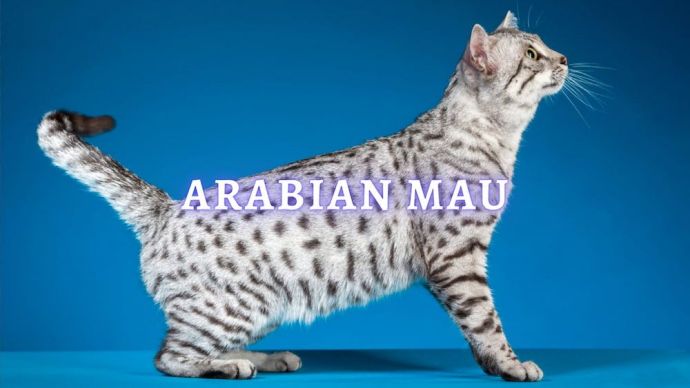 Cat Breeds Arabian Mau: History of Arabian Mau Cats, Personality, Care, Lifespan
Cat Breeds Arabian Mau: History of Arabian Mau Cats, Personality, Care, Lifespan - 1215
- 0
 Cat Breeds Cats That Look Like Leopards: 10 Cat Breeds That Look Exactly Like Leopards
Cat Breeds Cats That Look Like Leopards: 10 Cat Breeds That Look Exactly Like Leopards - 648
- 0
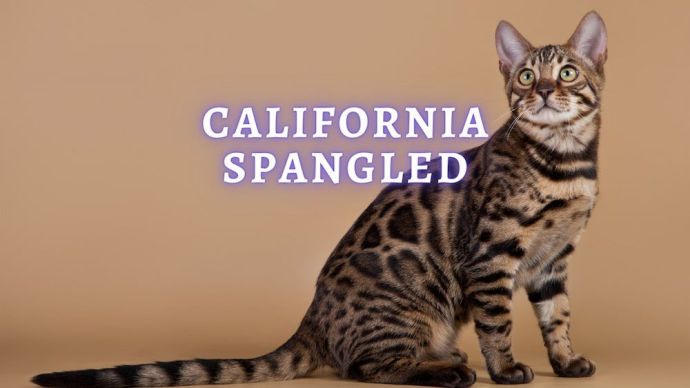 Cat Breeds California Spangled: California Spangled Cat Personality, Breed History, and Interesting Facts
Cat Breeds California Spangled: California Spangled Cat Personality, Breed History, and Interesting Facts - 313
- 0
 Cat Care Why Does My Cat Attack My Legs? 10 Reasons Why and What To Do About It (Vet-Approved Advice)
Cat Care Why Does My Cat Attack My Legs? 10 Reasons Why and What To Do About It (Vet-Approved Advice) - 46013
- 21
 Cat Veterinary Tips Cat Stomach Gurgling: Vet Advice on Why is Your Cat Stomach Gurgling?
Cat Veterinary Tips Cat Stomach Gurgling: Vet Advice on Why is Your Cat Stomach Gurgling? - 36469
- 4
 Cat Veterinary Tips My Cat Lost its Voice: Can Cats get Laryngitis? (Vet Advice)
Cat Veterinary Tips My Cat Lost its Voice: Can Cats get Laryngitis? (Vet Advice) - 23554
- 13












